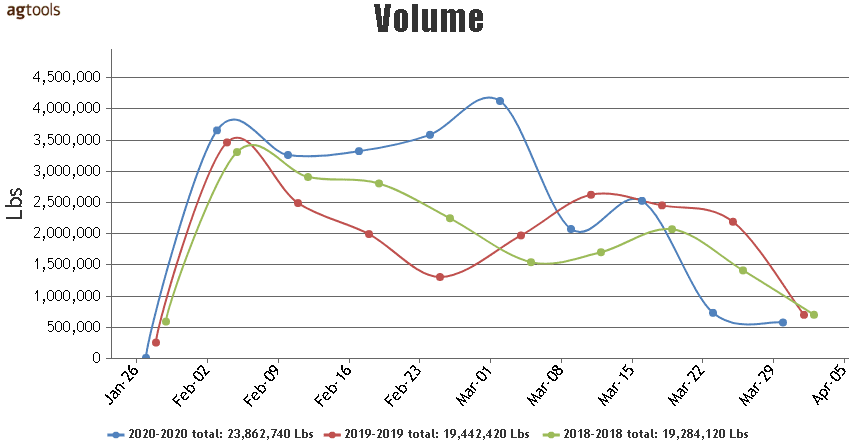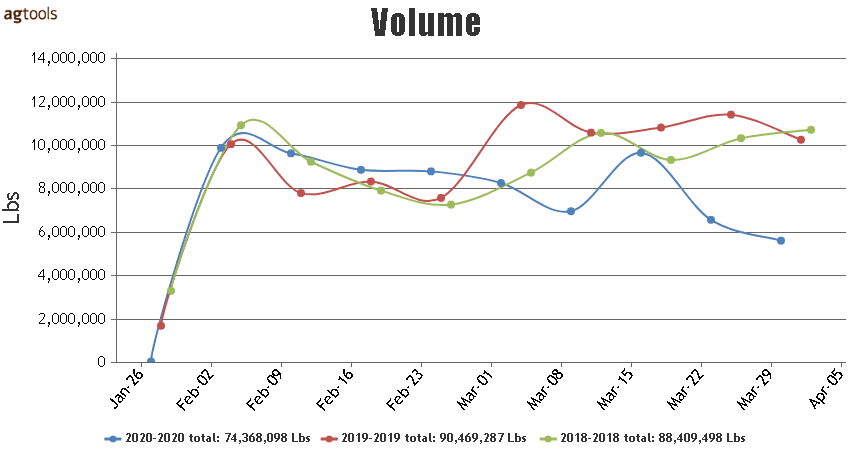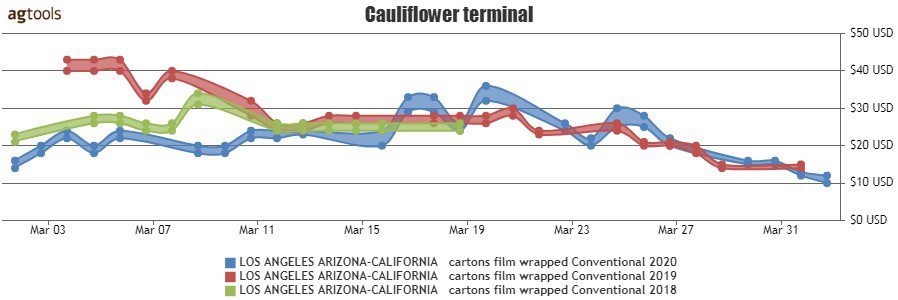
Broccoli and cauliflower are two more vegetables that have seen consumer demand drop since the mid-March retail surge as cities around the United States issues shelter-in-place orders.
Both broccoli and cauliflower prices dropped in half from about March 20, but cauliflower prices have shown rising FOBs the first week of April.
Blue Book has teamed with Agtools Inc., the data analytic service for the produce industry, for a look at volume and price trends for broccoli and cauliflower over the past few months.
CONVENTIONAL BROCCOLI CROWN CUT 20 LBS

Looking at broccoli from California, Arizona and Mexico, volume from mid-February through early March was higher than the past two seasons, but then it drops significantly after March 15.
“This is likely due to the public health emergency,” says Martha Montoya, CEO of Agtools. “Broccoli is highly perishable, and the consumer prefers to buy products with a longer shelf life. We estimate that the demand for broccoli with continue to decrease in the upcoming weeks.”
F.O.B PRICES

Arizona broccoli saw prices around $20 per carton in mid-March, but then it dropped in half to about $10 by the time April began.
“As it is the end of the season for that region, no improvement in pricing is expected in the near term,” Montoya says.
PRICING MEXICO ORIGIN, FOB MC ALLEN TX

Similarly, broccoli from Mexico crossing through Texas saw prices fall in half from mid-March to the end of the month.
“At the beginning of the month of March, with the onset of the public health emergency, there is a slight upward trend, and it stabilizes in the middle of the month between $13-16,” Montoya says. “This is when the consumer pulls back, and the demand decreases and consequently the price even below pricing in 2019 and 2018. Currently it appears to have stabilized between $5-6.50. Unfortunately, as long as the public health emergency continues, we don’t expect any increase in pricing for highly perishable products.”
PRICES: SALINAS – WATSONVILLE, CALIFORNIA

Broccoli from Salinas, CA, showed a similar pattern, with prices dropping in half from mid-March to the end of the month. However, prices have increased $1-2 the first week of April.
CAULIFLOWER
Similar to broccoli, cauliflower has seen dramatic movement during the pandemic.
This product is in transition in various regions. The volume graph combines the volumes of Mexico, Arizona, and Central California.
This year has seen generally shrinking volume from the beginning of February, and lower volume than the previous two years since the beginning of March.
“Pricing is below the prior two years and continues decreasing,” Montoya says. “Although pricing has not stabilized, the rate of decrease has slowed.”

F.O.B. PRICES, WESTERN ARIZONA SIZE 12s

F.O.B. PRICES, SALINAS-WATSONVILLE, CALIFORNIA

MARKET PRICING, TERMINAL LOS ANGELES

“The Los Angeles terminal market pricing shows the same tendencies as the regional markets, although we can observe the pricing at the end of March and beginning of April continues to decrease,” Montoya says. “Unfortunately, it has not reached bottom. We expect to see a small recovery in the upcoming days.”
Broccoli and cauliflower are two more vegetables that have seen consumer demand drop since the mid-March retail surge as cities around the United States issues shelter-in-place orders.
Both broccoli and cauliflower prices dropped in half from about March 20, but cauliflower prices have shown rising FOBs the first week of April.
Blue Book has teamed with Agtools Inc., the data analytic service for the produce industry, for a look at volume and price trends for broccoli and cauliflower over the past few months.
CONVENTIONAL BROCCOLI CROWN CUT 20 LBS

Looking at broccoli from California, Arizona and Mexico, volume from mid-February through early March was higher than the past two seasons, but then it drops significantly after March 15.
“This is likely due to the public health emergency,” says Martha Montoya, CEO of Agtools. “Broccoli is highly perishable, and the consumer prefers to buy products with a longer shelf life. We estimate that the demand for broccoli with continue to decrease in the upcoming weeks.”
F.O.B PRICES

Arizona broccoli saw prices around $20 per carton in mid-March, but then it dropped in half to about $10 by the time April began.
“As it is the end of the season for that region, no improvement in pricing is expected in the near term,” Montoya says.
PRICING MEXICO ORIGIN, FOB MC ALLEN TX

Similarly, broccoli from Mexico crossing through Texas saw prices fall in half from mid-March to the end of the month.
“At the beginning of the month of March, with the onset of the public health emergency, there is a slight upward trend, and it stabilizes in the middle of the month between $13-16,” Montoya says. “This is when the consumer pulls back, and the demand decreases and consequently the price even below pricing in 2019 and 2018. Currently it appears to have stabilized between $5-6.50. Unfortunately, as long as the public health emergency continues, we don’t expect any increase in pricing for highly perishable products.”
PRICES: SALINAS – WATSONVILLE, CALIFORNIA

Broccoli from Salinas, CA, showed a similar pattern, with prices dropping in half from mid-March to the end of the month. However, prices have increased $1-2 the first week of April.
CAULIFLOWER
Similar to broccoli, cauliflower has seen dramatic movement during the pandemic.
This product is in transition in various regions. The volume graph combines the volumes of Mexico, Arizona, and Central California.
This year has seen generally shrinking volume from the beginning of February, and lower volume than the previous two years since the beginning of March.
“Pricing is below the prior two years and continues decreasing,” Montoya says. “Although pricing has not stabilized, the rate of decrease has slowed.”

F.O.B. PRICES, WESTERN ARIZONA SIZE 12s

F.O.B. PRICES, SALINAS-WATSONVILLE, CALIFORNIA

MARKET PRICING, TERMINAL LOS ANGELES

“The Los Angeles terminal market pricing shows the same tendencies as the regional markets, although we can observe the pricing at the end of March and beginning of April continues to decrease,” Montoya says. “Unfortunately, it has not reached bottom. We expect to see a small recovery in the upcoming days.”
Greg Johnson is Director of Media Development for Blue Book Services











